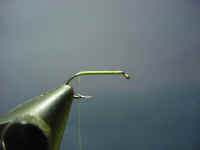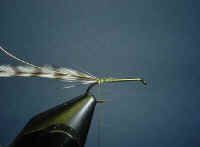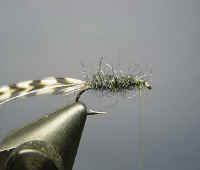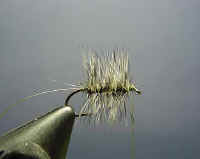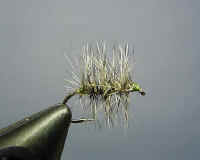|
Fly of the Month Bob Ireton brings together his experience in fly fishing, aquatic entomology, and knowledge of fly tying techniques and materials, to design and tie durable and effective flies. |

|
![]()
Volume 3, Issue 2
February 2002
![]()
GRIFFITH'S GNAT
Fly and Text by Bob Ireton
Photography by Bob Kimsey and Bob Ireton
The Grifith's Gnat is a 'go to' fly whenever small midges are hatching. Tie on a size 18 or 20 when you can't see the insect that is causing a rise of trout.
George Griffiths, one of the founding fathers of Trout Unlimited, created one of our most important midge dressings. The Griffith's gnat is simple, no more than a peacock herl or dubbed body, overwound with grizzly hackle. You can change the body to various midge colors of gray, olive, black, or tan.
The beauty of the fly is the way it floats half in and half out of the surface film. It represents something stuck, trying to emerge from its shuck. It seems like there is always a midge hatch, so this is one fly that I recommend having in your fly box!
MATERIALS
Hook - TMC 100, Dai-Riki 300, Daiichi 1100, Mustad 94840, Orvis 1509
Size 14-28
Thread - Olive 8/0
Rib - Fine gold tinsel or wire
Hackle - Grizzly dry fly hackle, palmered
Body - Synthetic peacock dubbing
TYING STEPS
Note - By now you have noticed that I tie a durable fly by taking a little more time and effort, such as adding a half hitch after various steps, in addition to a whip finish and head cement.. The small amount of extra weight this might add does not noticeably affect the performance of the fly. It is a lot easier to do this at the tying bench instead of having to change a fly in the heat of a hatch because the fly fell apart after catching a fish or two!
![]()
Copyright © 1998 - thisyear The Buckeye United Fly Fishers, Inc. Cincinnati, OH 45242
The Buckeye United Fly Fishers, Inc is a non-profit corporation organized under section 501(c)(3) of the Internal Revenue Code, incorporated in the State of Ohio for the preservation, conservation and wise use of our fishing waters and game fish; and to assist in the protection and improvement of our natural resources
